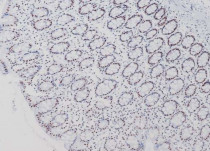ARG66924
anti-BRG1 antibody [SQab22252]
anti-BRG1 antibody [SQab22252] for IHC-Formalin-fixed paraffin-embedded sections,Western blot and Human

1
Overview
| Product Description | Recombinant Rabbit Monoclonal antibody [SQab22252] recognizes BRG1 |
|---|---|
| Tested Reactivity | Hu |
| Tested Application | IHC-P, WB |
| Host | Rabbit |
| Clonality | Monoclonal |
| Clone | SQab22252 |
| Isotype | IgG |
| Target Name | BRG1 |
| Antigen Species | Human |
| Immunogen | Full length protein corresponding to Human BRG1. |
| Conjugation | Un-conjugated |
| Protein Full Name | Transcription activator BRG1 |
| Alternate Names | BRG1-associated factor 190A; SNF2-beta; RTPS2; SNF2L4; SWI/SNF-related matrix-associated actin-dependent regulator of chromatin subfamily A member 4; Transcription activator BRG1; BAF190A; EC 3.6.4.-; Protein BRG-1; SNF2LB; ATP-dependent helicase SMARCA4; MRD16; BAF190; Mitotic growth and transcription activator; BRG1; Protein brahma homolog 1; SNF2; hSNF2b; SWI2 |
Application Instructions
| Application Suggestion |
|
||||||
|---|---|---|---|---|---|---|---|
| Application Note | IHC-P: Antigen Retrieval: Heat mediated was performed using Tris/EDTA buffer (pH 9.0). Incubate the samples at RT (18-25°C) for 30 min. * The dilutions indicate recommended starting dilutions and the optimal dilutions or concentrations should be determined by the scientist. |
||||||
| Positive Control | Human colon tissue | ||||||
| Observed Size | 185 - 220 kDa |
Properties
| Form | Liquid |
|---|---|
| Purification | Purification with Protein A. |
| Buffer | PBS, 0.01% Sodium azide, 40% Glycerol and 0.05%BSA. |
| Preservative | 0.01% Sodium azide |
| Stabilizer | 40% Glycerol and 0.05%BSA |
| Storage Instruction | For continuous use, store undiluted antibody at 2-8°C for up to a week. For long-term storage, aliquot and store at -20°C or below. Storage in frost free freezers is not recommended. Avoid repeated freeze/thaw cycles. Suggest spin the vial prior to opening. The antibody solution should be gently mixed before use. |
| Note | For laboratory research only, not for drug, diagnostic or other use. |
Bioinformation
| Database Links | |
|---|---|
| Gene Symbol | SMARCA4 |
| Gene Full Name | SWI/SNF related, matrix associated, actin dependent regulator of chromatin, subfamily a, member 4 |
| Background | The protein encoded by this gene is a member of the SWI/SNF family of proteins and is similar to the brahma protein of Drosophila. Members of this family have helicase and ATPase activities and are thought to regulate transcription of certain genes by altering the chromatin structure around those genes. The encoded protein is part of the large ATP-dependent chromatin remodeling complex SNF/SWI, which is required for transcriptional activation of genes normally repressed by chromatin. In addition, this protein can bind BRCA1, as well as regulate the expression of the tumorigenic protein CD44. Mutations in this gene cause rhabdoid tumor predisposition syndrome type 2. Multiple transcript variants encoding different isoforms have been found for this gene. [provided by RefSeq, May 2012] |
| Function | Transcriptional coactivator cooperating with nuclear hormone receptors to potentiate transcriptional activation. Component of the CREST-BRG1 complex, a multiprotein complex that regulates promoter activation by orchestrating a calcium-dependent release of a repressor complex and a recruitment of an activator complex. In resting neurons, transcription of the c-FOS promoter is inhibited by BRG1-dependent recruitment of a phospho-RB1-HDAC repressor complex. Upon calcium influx, RB1 is dephosphorylated by calcineurin, which leads to release of the repressor complex. At the same time, there is increased recruitment of CREBBP to the promoter by a CREST-dependent mechanism, which leads to transcriptional activation. The CREST-BRG1 complex also binds to the NR2B promoter, and activity-dependent induction of NR2B expression involves a release of HDAC1 and recruitment of CREBBP. Belongs to the neural progenitors-specific chromatin remodeling complex (npBAF complex) and the neuron-specific chromatin remodeling complex (nBAF complex). During neural development a switch from a stem/progenitor to a post-mitotic chromatin remodeling mechanism occurs as neurons exit the cell cycle and become committed to their adult state. The transition from proliferating neural stem/progenitor cells to post-mitotic neurons requires a switch in subunit composition of the npBAF and nBAF complexes. As neural progenitors exit mitosis and differentiate into neurons, npBAF complexes which contain ACTL6A/BAF53A and PHF10/BAF45A, are exchanged for homologous alternative ACTL6B/BAF53B and DPF1/BAF45B or DPF3/BAF45C subunits in neuron-specific complexes (nBAF). The npBAF complex is essential for the self-renewal/proliferative capacity of the multipotent neural stem cells. The nBAF complex along with CREST plays a role regulating the activity of genes essential for dendrite growth. SMARCA4/BAF190A may promote neural stem cell self-renewal/proliferation by enhancing Notch-dependent proliferative signals, while concurrently making the neural stem cell insensitive to SHH-dependent differentiating cues (By similarity). Acts as a corepressor of ZEB1 to regulate E-cadherin transcription and is required for induction of epithelial-mesenchymal transition (EMT) by ZEB1. [UniProt] |
| Cellular Localization | Nucleus. Note=Colocalizes with long non-coding RNA Evf2 in nuclear RNA clouds. [UniProt] |
| Calculated MW | 185 kDa |
Images (2) Click the Picture to Zoom In
-
ARG66924 anti-BRG1 antibody [SQab22252] IHC-P image
Immunohistochemistry: Formalin/PFA-fixed and paraffin-embedded sections of Human colon tissue stained with ARG66924 anti-BRG1 antibody [SQab22252]. Antigen Retrieval: Heat tissue section in Tris-EDTA buffer (pH 9.0).
-
ARG66924 anti-BRG1 antibody [SQab22252] WB image (Customer review)
Western blot: Hela stained with ARG66924 anti-BRG1 antibody [SQab22252] at 1:500 dilution.







